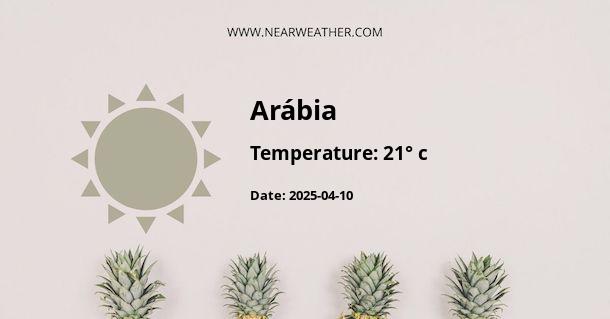Climate and Weather in Arabia
Arabia, located in the Arabian Peninsula, is known for its diverse climate and unique weather patterns. The region consists of several countries, including Saudi Arabia, Yemen, Oman, Qatar, and the United Arab Emirates. Each country has its own variations in climate, but they all share some common characteristics.
Desert Climate
The majority of Arabia experiences a desert climate, characterized by extremely hot and dry conditions. Summers are scorching, with temperatures often exceeding 40 degrees Celsius (104 degrees Fahrenheit), while winters are relatively mild, with temperatures ranging between 15 and 25 degrees Celsius (59 to 77 degrees Fahrenheit). The arid desert landscape receives very little rainfall throughout the year, with annual precipitation averaging less than 100 millimeters (4 inches).
The desert climate in Arabia is influenced by the surrounding geographical features, such as the Arabian Sea and the Red Sea, as well as the vast stretches of sand dunes and rocky terrain. These factors contribute to the region's extreme temperature fluctuations, low humidity levels, and minimal cloud cover.
Coastal Climate
Arabia also has a coastal climate along its extensive coastline, which stretches along the Arabian Sea and the Persian Gulf. The coastal areas experience more moderate temperatures compared to the inland desert regions. Summers are hot and humid, with temperatures ranging from 30 to 45 degrees Celsius (86 to 113 degrees Fahrenheit), while winters are mild and pleasant, with temperatures averaging between 20 and 30 degrees Celsius (68 to 86 degrees Fahrenheit).
Coastal regions in Arabia receive slightly higher amounts of rainfall compared to the interior desert areas. Annual precipitation varies between 100 and 300 millimeters (4 to 12 inches), with the majority of rainfall occurring during the winter months.
Mountain Climate
The mountainous regions of Arabia, such as the Al Hajar Mountains in Oman and the Asir Mountains in Saudi Arabia, have a unique climate due to their higher elevations. These areas experience cooler temperatures compared to the surrounding desert and coastal regions.
Summers in the mountains are relatively mild, with temperatures ranging from 20 to 30 degrees Celsius (68 to 86 degrees Fahrenheit), while winters can be cold, with temperatures dropping below freezing point and occasional snowfall. Precipitation in the mountainous areas is higher compared to the rest of Arabia, with annual rainfall ranging from 300 to 600 millimeters (12 to 24 inches).
Sandstorms and Dust Storms
Arabia is also known for its frequent sandstorms and dust storms, particularly in the desert regions. These storms occur when strong winds pick up loose sand and dust particles, creating a haze that reduces visibility and can be hazardous to health. Sandstorms and dust storms are more common during the summer months when hot and dry conditions prevail.
It is important for residents and visitors in Arabia to take necessary precautions during these storms, such as staying indoors, wearing protective clothing, and using masks to avoid inhaling dust particles.
Weather Patterns
The weather patterns in Arabia are influenced by various factors, including the Indian Ocean monsoon, the Mediterranean Sea, and the Arabian Sea. The monsoon season, which typically occurs from June to September, brings occasional rainfall to the southern parts of Arabia, including Yemen and Oman.
The Mediterranean Sea influences the weather in the northern parts of Arabia, such as Jordan and Syria, where winters can be colder and receive more precipitation compared to the rest of the region.
The Arabian Sea and the Persian Gulf also play a significant role in shaping the weather in coastal areas of Arabia. These bodies of water contribute to the high humidity levels and occasional tropical cyclones that may affect the region, particularly during the summer and early autumn months.
Conclusion
Arabia's climate and weather vary across the region, with desert, coastal, and mountainous areas experiencing distinct conditions. The desert climate dominates much of Arabia, with scorching hot summers, mild winters, and minimal rainfall. Coastal regions have more moderate temperatures and slightly higher rainfall, while mountainous areas enjoy cooler temperatures and increased precipitation. Sandstorms and dust storms are common in the desert regions, while the monsoon season and the influence of nearby bodies of water contribute to variations in weather patterns. Understanding the climate and weather in Arabia is essential for residents, travelers, and industries operating in the region.
A - Arábia's Latitude is 37.016670 & Longitude is -7.966670.
A - Weather in Arábia is 21° today.
A - Climate Conditions in Arábia shows clear sky today.
A - Humidity in Arábia is 52% today.
A - Wind speed in Arábia is 12.96 km/h, flowing at 50° wind direction. today.
